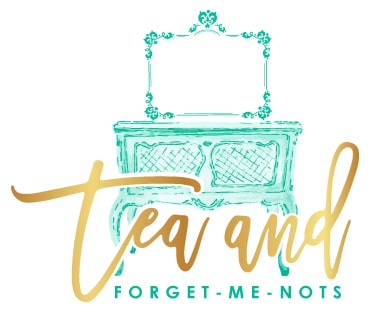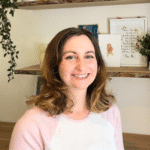The ultimate guide to upcycling terms and jargon
From laying off to keying surfaces, this guide covers the commonly confusing and searched-for upcycling terms and jargon.
Find yourself constantly Googling what things mean? There’s always something to learn.
Missing something? Let me know in the comments.
The ultimate guide to upcycling terms and jargon
A
Antique – something that is 100+ years old.
B
Bleed-through – colour from tannins in dark wood showing through coats of paint. The only way to cover the stain is with a stain blocker or an oil-based paint first.
Blending (see ombre).
Burnish – to rub a material such as a furniture transfer with a tool to attach it to the new surface.
C
Caulking – the process of filling gaps and sealing joints between building components with a flexible, waterproof material called caulk.
Chalk paint – water-based paint made from chalk. Can use on most clean, dry surfaces without preparation steps. Clean brushes with soap and water.
Chipboard – an engineered sheet of wood made from small wood chippings, bound together by a synthetic resin. Similar to MDF but less dense.
Cottagecore – (also known as Farmcore and Countrycore) is an aesthetic style inspired by romanticised interpretations of rural and farm lifestyles.
Cure – paint is cured when it has fully hardened, not just dry. This can take several weeks but is then durable enough to wash the surface, put objects on and be more resistant to scratches.
D
Decoupage – the art of decorating surfaces by applying paper and then coating with several layers of protective finish such as lacquer or glue.
Denatured alcohol (see methylated spirits).
Distressed – the look of old or worn furniture created by sanding paint in places where it would naturally wear away due to use. Popular in the shabby chic style.
Dry brushing – a painting technique using a paint brush with very little paint. The resulting brush strokes have a scratchy look.
E
Eggshell – a paint finish which looks like the surface of an eggshell. It sits between a matt and a silk finish.
Elmer’s Glue (see PVA glue).
Extender – a product added to paint to increase the length of time the paint stays wet, to be able to work with it for longer before it dries.
G
Gloss – a shine-based paint finish. The most resistant and hard-wearing of paint sheens.
Grit – sandpaper is rated in grits which is the size of the abrasive material on the sandpaper. A higher grit number is a finer abrasive, which creates smoother surface finishes. Lower grit numbers represent coarser abrasives which scrape off materials quicker.
K
Keying – the process of roughing up a surface by scoring or sanding it, to provide a good surface to apply primer, paint or varnish to. You can key bare surfaces or ones that have been already painted or varnished.
L
Laminate – a material with a coating made to look like wood. Known for its durability and reliability.
Laying off – a process to remove brush strokes in paint. Make long sweeping strokes, softly along the surface with a brush. With each pass, soften the stroke and the brush marks will lessen each time.
Subscribe for my best tips and products
M
Matt – a flat paint finish. Provides a non-reflective, smooth appearance. Matt paint requires fewer coats than higher gloss paints and is easier to touch up.
MDF – an engineered wood product made from very small pieces of wood which have been pressed and stuck together. Ideal for cutting, machining and drilling, since it does not chip easily. Similar to chipboard but denser.
Methylated spirits (denatured alcohol) – an alcohol-based solvent suitable for thinning paints, lacquers, and varnishes. Can also be used as a cleaner and degreaser for paint brushes, paint work and glassware.
Mineral paint – a water-based acrylic paint. Clean brushes with soap and water.
Mineral spirits (see white spirits)
Mod Podge – a glue, sealer, and finish for arts and craft projects.
O
Ombre – the transition of a lighter shade from a darker shade.
P
Paint (oil-based) – clean brushes with mineral spirits or paint thinner.
Paint (water-based) – such as acrylic and latex paint. Clean brushes with soap and water.
Painter’s tape – used to create a clean paint edge with no bleeding by removing the tape when the paint is still wet.
Polycrylic – a water-based protective layer for interior surfaces. Clean brushes with soap and water. Leaves a clear, non-yellowing surface, so it won’t change the appearance of white paint. Not recommended for use over dark-colored paints where it can appear opaque or milky.
Polyurethane – a water or oil-based protective layer for interior or exterior surfaces. Not recommended for white or light-coloured paint as it can yellow or become slightly cloudy.
Primer – provides a uniform surface for paint to stick to. Covers imperfections such as repairs and blocks and conceals stains so they don’t bleed through a newly painted finish.
PVA glue (Elmer’s glue/white glue/ woodworking glue) – ideal for glueing paper but does not work well on materials such as metal or plastic.
R
Raised stencil – apply a plaster or plaster-type medium over a stencil design. Once the stencil is removed, the design is raised above the surface.
S
Satin – a mid-sheen paint finish. A slightly polished surface that reflects a bit of light.
Scuff sand (see keying)
Shabby chic – an interior design style that embraces a worn, lived-in look, whitewashed furniture and faded floral prints.
Shellac – a resin processed and dissolved in alcohol to make liquid shellac, which is used to seal wood or as a stain-blocking primer.
Silk – a mid-sheen paint finish. A slightly polished surface that reflects a bit of light.
Solid wood – lumber that has been cut directly from trees.
T
Tannins – the chemicals in liquid sap in wood. These can cause dark stains to show up on light coloured paint, if not prepared with a stain-blocking wood primer.
Top coat – a final layer to protect paint, particularly important for high traffic areas such as table tops. Top coats could be in the form of wax, polyurethane or polycrylic.
Transfer – a pre-printed design such as a pattern, words or an image on a backing sheet that gets rubbed onto a surface. Pull away the backing sheet and the design stays behind.
TSP – a cleaner used for removing grease and paint from concrete and brick, prepping walls for painting and preparing walls for wallpapering.
U
Undercoat – a primer for an already painted surface. When transitioning from a dark to a light colour, an undercoat will help cover the colour below.
V
Varnish – a clear, transparent, hard protective coating. It is primarily used as a wood finish where the grains in the wood are intended to be visible.
Veneer – thin slices of wood that are pressed onto the surface of a furniture piece. Requires maintenance and care since they are prone to scratches.
Vintage – something that is 20-100 years old.
W
Wet sanding – a process of using special sandpaper that is wet with water. The water acts like a lubricant plus helps remove tiny particles so that the sandpaper does not get clogged and create deep scratches.
Whitewash – a paint effect which gives a transparent look. Create by mixing paint with water. Add more paint for a less transparent finish.
White spirits (mineral spirits) – a petroleum-based solvent, used for cleaning paintbrushes, thinning oil-based paint, cleaning and degreasing. Can be disposed of at landfill and should not be poured down the sink.
Working time – the amount of time you have to work with a product, such as paint, before it dries.
Thank you for the upcycling terms and jargon contributions from the Facebook groups Upcycling Ideas, Help and Inspiration and Furniture Painters Unite UK.
If you found this helpful, you might also enjoy this one about painting hacks…
Pin it for later – upcycling terms and jargon

Hi there! I'm Rachel Bowyer, a passionate DIY enthusiast with a knack for transforming the old into something beautifully new. With a deep love for furniture painting, refinishing, and the art of crafting. I've been documenting my DIY projects and restoration journey since 2018. I specialise in techniques like decoupage, stencilling, and decor transfers. Join me as we explore the world of creativity and home improvement, one project at a time.

